Many teams view IT risk management as a defensive chore, a checklist of compliance tasks managed in spreadsheets. This outdated approach creates information silos and leaves organizations reacting to problems instead of getting ahead of them. Modern IT risk is dynamic and requires continuous vigilance, which manual methods cannot sustain. To achieve true resilience, risk assessment must become a seamless, integrated part of your daily operations.
The right IT risk management software transforms this process by integrating risk awareness directly into daily workflows. With a unified platform, teams can shift from a reactive burden to a proactive strategy that strengthens the entire organization.
This guide explores how to make that shift. It will cover the essential features and benefits of these platforms, compare top options on the market, and provide best practices for implementation and measuring ROI. The article begins by defining what makes this software a cornerstone of resilient IT operations.
Key takeaways
- Strategic Shift: the right IT risk management software transforms the process from a defensive, checklist-based chore into a proactive strategy by integrating risk awareness directly into daily operational workflows.
- Unified Command: these platforms replace fragmented spreadsheets with a centralized command center for identifying, assessing, and mitigating threats, enabling teams to prioritize the most significant risks first.
- Proactive Resilience: effective solutions must offer automated asset and vulnerability discovery, continuous monitoring, and intelligent filtering to eliminate blind spots and enable instant response plans.
- Operational Integration: platforms like monday service elevate risk management by linking risk assessment, monitoring, and mitigation directly into the broader service delivery ecosystem, connecting risks to projects and incidents.
- Measuring Value: key benefits include centralized compliance, streamlined audit preparation, and optimized resource allocation, transforming risk management from a cost center into a source of competitive advantage.
What is IT risk management software?
IT risk management software serves as a centralized command hub for identifying, assessing, and mitigating technological threats. It provides the framework to proactively address vulnerabilities, from security gaps to potential system outages, preventing disruptions before they impact operations. This strategic approach shifts teams from a reactive posture to one of proactive defence.
Its primary function is to replace fragmented, manual tracking methods like spreadsheets with a unified, automated digital workspace. This consolidation allows teams to stop chasing disparate data points and instead focus on anticipating future challenges. The result is the ability to prioritize the most significant risks first and make intelligent, confident decisions.
Platforms such as monday service elevate this capability by integrating risk management directly into the broader operational ecosystem. Risks are no longer isolated concerns; they become intrinsically linked to projects and incidents, fostering a seamless, resilient environment where all stakeholders maintain shared awareness.
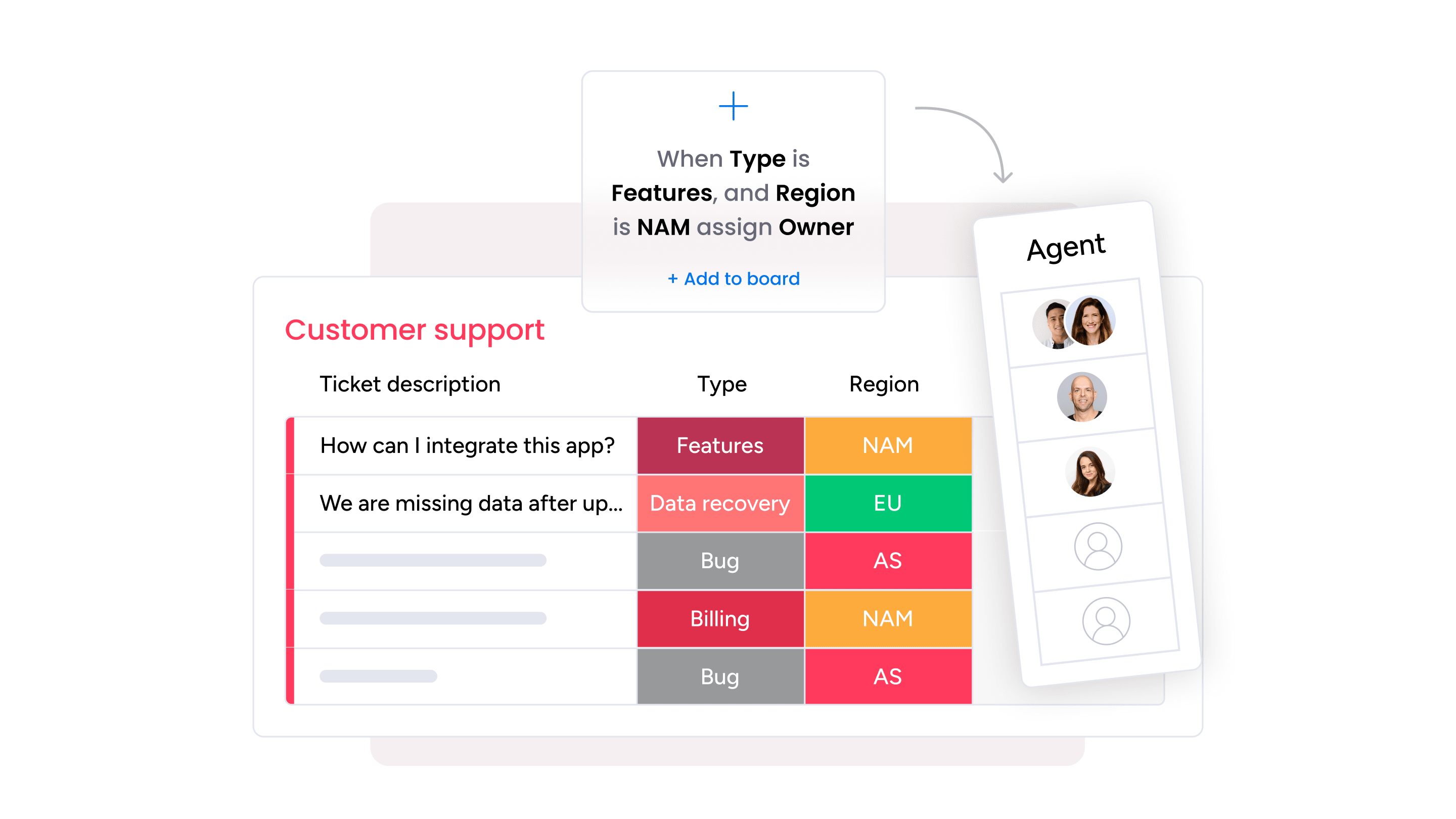
IT risk management vs cyber risk management platforms
Establishing the difference between IT risk management and cyber risk management is really important when building an effective organizational defence strategy. Although both disciplines aim to protect corporate assets, their scope and focus differ significantly, and selecting the appropriate platform depends on understanding these core differences.
IT risk management encompasses a broad operational scope, addressing everything from infrastructure failures and data loss to regulatory compliance gaps that could disrupt business continuity.
In contrast, cyber risk management is a specialized discipline concentrated exclusively on defending against external, malicious threats like data breaches, malware, and phishing attacks.
The different focus of each platform is reflected in their typical integrations. IT risk platforms are designed to connect with service management systems like monday Service, creating a direct link between risk identification and operational response.
Cyber risk platforms, however, prioritize integration with security-specific tools, as their primary mission is to fortify the digital perimeter against external attacks.
Essential features of IT risk management solutions
Effective IT risk management solutions are more than simple alert systems; they are comprehensive platforms designed to build proactive resilience. The most valuable platforms empower teams to transition from a reactive stance to a strategic one, enabling them to anticipate threats and transform potential disruptions into managed, controlled outcomes.
The core features required for this transition include:
- Automated asset and vulnerability discovery: continuously scans the entire IT landscape, from sanctioned cloud services to shadow IT, to create a complete, real-time inventory. This eliminates blind spots and provides an accurate map of the digital environment.
- Intelligent alert filtering and integration: crucial for moving beyond manual monitoring. By intelligently filtering alerts and integrating them directly into service management platforms like monday service, response plans can be initiated instantly.
- Instant response initiation: to instantly assign the right personnel without delay minimizes time spent on low-value tasks and maximizes the team’s capacity for strategic action.

Key benefits of IT risk management software
The adoption of IT risk management software facilitates a fundamental shift from reactive problem-solving to proactive strategy. By providing the tools to anticipate and mitigate issues before they escalate, these platforms enable organizations to make smarter, data-driven decisions.
This forward-looking approach is the cornerstone of operational resilience, ensuring business objectives remain the central focus.
The key benefits that these comprehensive platforms deliver include:
- Centralized compliance and governance: the software acts as a single source of truth, consolidating regulatory requirements and audit trails into a streamlined dashboard. This simplifies audit preparation and ensures critical compliance deadlines are met.
- Optimized resource allocation: automation and advanced analytics work in tandem to optimize costs. By automating repetitive tasks, the platform allows skilled personnel to concentrate on high-impact, strategic initiatives.
- Proactive resilience: the ability to anticipate and mitigate issues before they escalate ensures business continuity and shifts the organization from a reactive posture to a cornerstone of operational resilience.
- Strategic investment insight: real-time data provides the necessary insights for confident, strategic investments, transforming risk management from a necessary cost center into a source of competitive advantage.
Top IT risk management software platforms compared
Selecting an IT risk management platform requires looking beyond a simple list of features. The most effective solution is one that integrates seamlessly into daily operations, augmenting existing workflows rather than creating new, disconnected processes. The goal is to find a platform that becomes an organic part of the operational fabric.
A platform with high usability provides a single, real-time picture of your risk posture that the entire team can adopt without extensive training. It transforms risk management from a static report into a dynamic, actionable part of your workflow. This means teams are not just identifying risks; they are collaborating to resolve them instantly.
Below, we will explore the platforms that are leading the market. We’ll break down what makes each one stand out and help you spot the right fit for your team’s unique rhythm and goals.
1. monday service
monday service transforms IT risk management from a reactive headache into a proactive powerhouse that actually works with your team’s daily workflow. Unlike traditional risk management tools that live in isolation, this platform weaves risk assessment, monitoring, and mitigation directly into your existing service operations. Teams love how it breaks down silos between departments while making complex risk scenarios feel manageable and actionable.
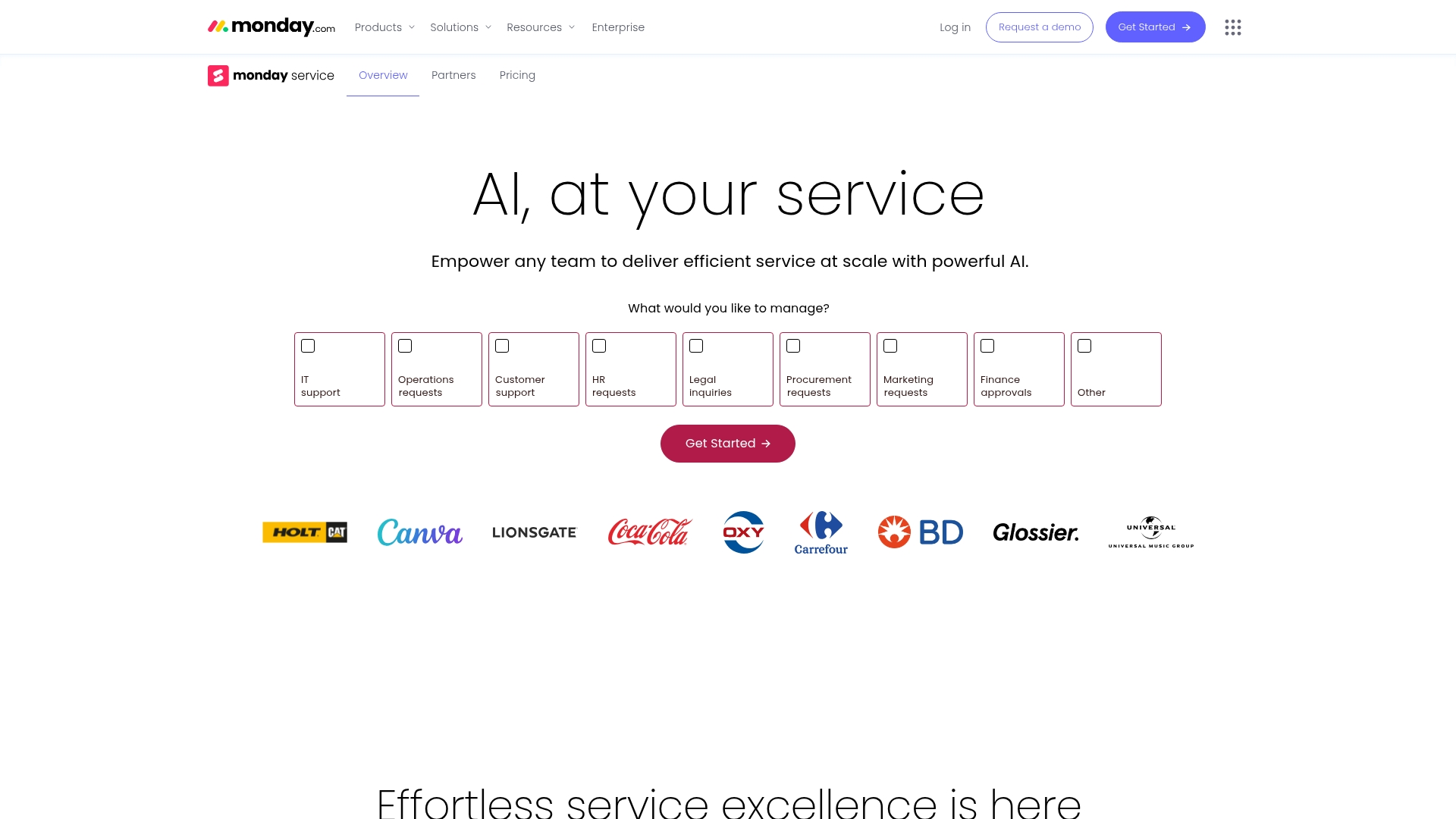
Example:
Organizations are empowered by monday service to embed risk management seamlessly into their service delivery workflows, creating a unified approach where risk assessment becomes part of daily operations rather than a separate compliance exercise.
Key features:
- Customizable risk register templates: that adapt to any team’s specific workflow and risk categories.
- AI Assistant: to help summarize risk data, generate action items, and draft communications.
- Real-time dashboards: that provide executive-level visibility into risk landscapes across all departments.
Pricing:
- Free: $0 (up to two seats, three boards, basic features).
- Basic: $9/month per seat (billed annually, unlimited viewers, 5GB storage).
- Standard: $12/month per seat (billed annually, 250 automation and integration actions/month, timeline views).
- Pro: $19/month per seat (billed annually, advanced features, 25K automation actions/month).
- Enterprise: contact sales for quote (portfolio management, enterprise-scale features, 24/7 support).
- Minimum requirement: three users.
- Annual billing: 18% discount.
Why it stands out:
- Cross-departmental collaboration and integration: connects risk management with ticketing, knowledge management, and service delivery in one unified platform. Features include seamless integration with 200+ enterprise applications (like ServiceNow, Jira, Slack, and Microsoft Teams), robust API access, and real-time data synchronization across your entire tech stack.
- No-code customization: offers a no-code approach that lets any team member build and adapt risk workflows without technical expertise. The no-code automation builder creates custom workflows for assigning risk owners, sending notifications, and updating stakeholders.
- Advanced AI features: includes an AI Assistant to help teams work faster by summarizing complex notes, drafting communications, generating task lists from risk descriptions, and calculating custom risk scores using formulas generated for your boards.
- Enterprise-scale automation: provides comprehensive automation features, including pre-built recipes for common scenarios (incident response, compliance monitoring, and change management approvals) and enterprise-scale capabilities supporting up to 250K actions per month, ensuring risk processes scale seamlessly.
- Comprehensive IT risk features: delivers core IT risk capabilities such as comprehensive risk register management with full audit trails, automated risk monitoring and alerting when thresholds are exceeded, and executive reporting for C-suite decision-making.
2. ServiceNow
ServiceNow transforms IT risk management from reactive firefighting into proactive, automated protection across your entire enterprise. The platform integrates seamlessly with existing IT operations, making it the go-to choice for large organizations that need enterprise-grade governance, risk, and compliance capabilities built into their daily workflows.
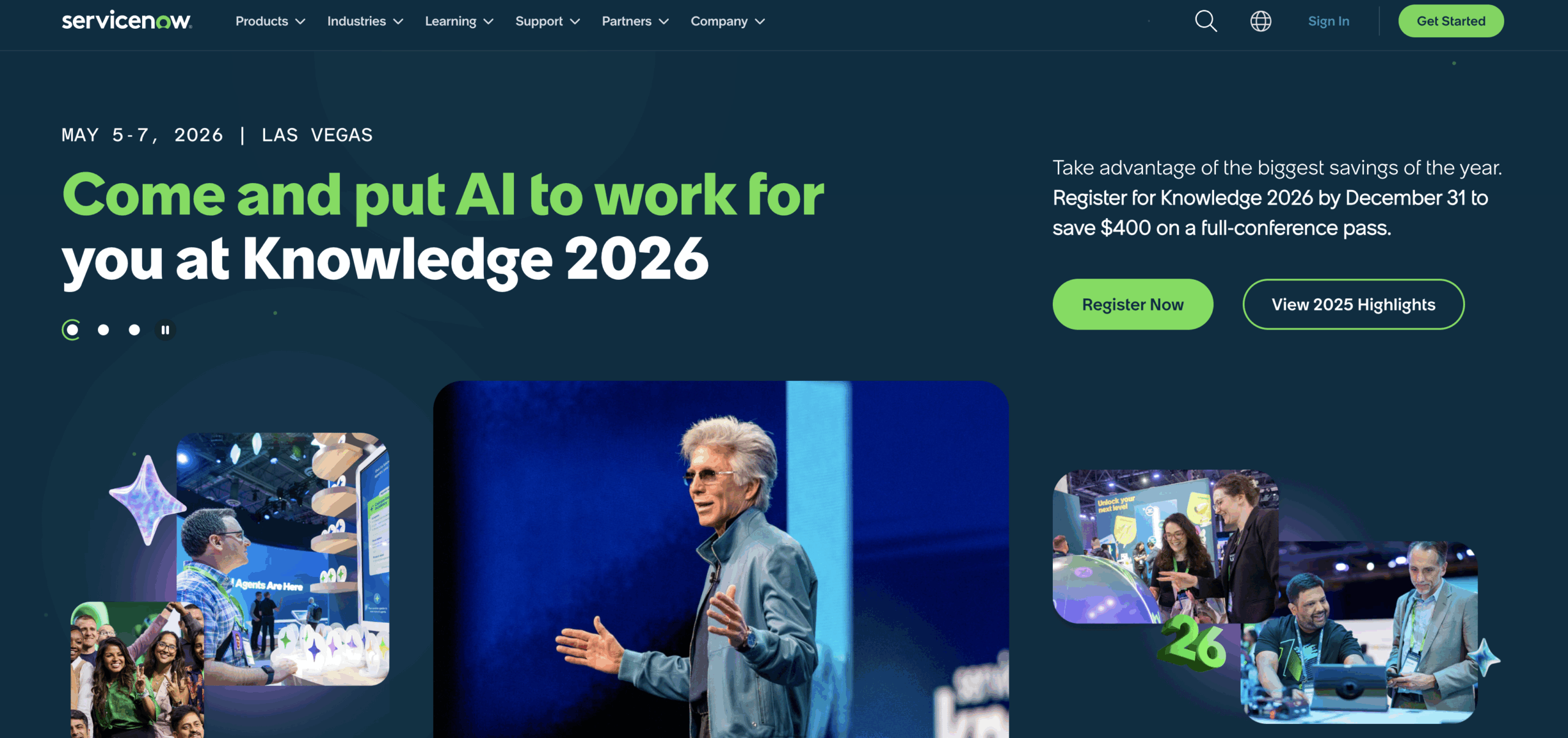
Example:
ServiceNow’s Integrated Risk Management (IRM) enables organizations to embed risk assessment and compliance monitoring directly into their operational workflows, providing real-time visibility and automated responses to emerging threats.
Key features:
- Integrated platform approach: connects risk management with IT service management, CMDB, and other business operations on a single platform for holistic risk visibility.
- AI-powered automation: leverages machine learning for predictive risk scoring, automated assessment responses, and intelligent incident triggering based on operational changes.
- Enterprise-scale compliance: supports multiple frameworks like SOX, HIPAA, GDPR, ISO 27001, and NIST with automated policy lifecycle management and continuous monitoring.
Pricing:
- Custom pricing: based on organizational needs and does not publish standard rates.
- Quote required: contact ServiceNow directly.
Considerations:
- High implementation complexity: requires specialized expertise and careful planning for successful deployment, often necessitating partner assistance.
- Significant cost investment: annual subscriptions can start above $50,000 and escalate quickly as more frameworks and modules are added, making it primarily suitable for large enterprises.
3. OneTrust Tech Risk & Compliance
OneTrust Tech Risk & Compliance delivers comprehensive risk management through a unified trust intelligence platform that connects privacy, security, and governance. The solution specializes in automated compliance across 55+ frameworks and AI-powered risk assessments, making it ideal for large enterprises managing complex regulatory environments.
With over 14,000 customers including 75% of the Fortune 100 (as reported by OneTrust in 2024), OneTrust has established itself as the market leader in privacy-centric risk management.
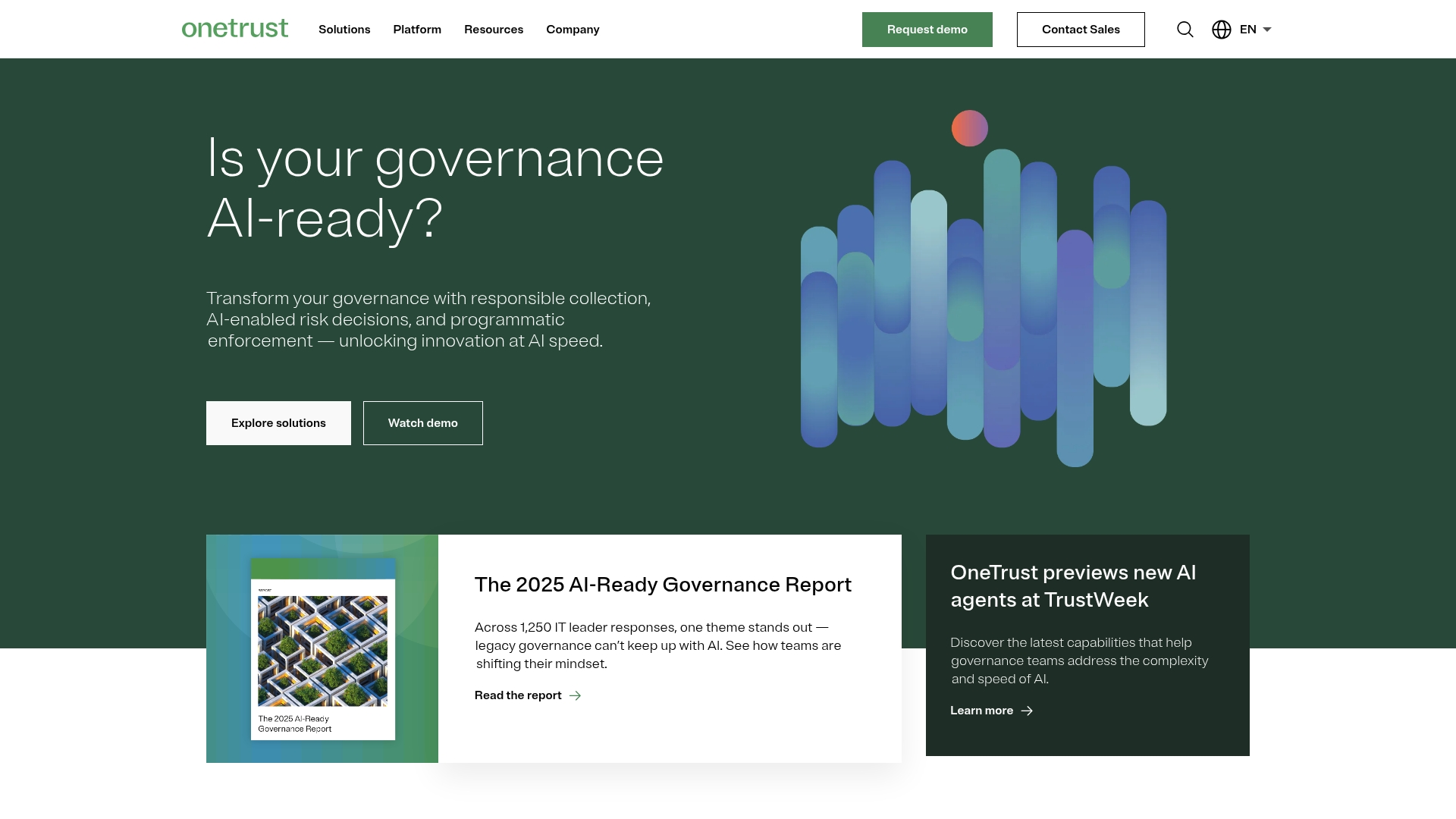
Example:
OneTrust breaks down traditional silos by integrating privacy, security, data governance, and GRC into a single platform that provides enterprise-wide risk visibility and automated compliance management.
Key features:
- Automated compliance framework management: ready-to-action content for 55+ frameworks with shared evidence collection across multiple compliance requirements.
- AI-powered risk assessment and scoring: dynamic risk aggregation with automated mapping of systems, data, and risks throughout internal and external enterprise operations.
- Third-party risk management with Vendorpedia: pre-completed vendor risk assessments database that accelerates due diligence and automates the entire vendor lifecycle.
Pricing:
- Tiered pricing: based on the number of admin users and the size of the asset inventory managed by the solution.
- Quote required: not published publicly; contacting OneTrust is required for a personalized quote.
Considerations:
- Complexity for smaller organizations: the comprehensive platform can be overwhelming for businesses without dedicated compliance and risk management teams.
- Steep learning curve: users report the dashboard and language can be non-intuitive, requiring significant time and training to master the risk management modules.
4. MetricStream IT Risk Management
MetricStream IT Risk Management delivers comprehensive GRC capabilities that transform how organizations identify, assess, and mitigate IT and cyber risks across their entire enterprise. The platform specializes in quantifying cyber risk in monetary terms and integrating IT risk management with broader enterprise risk functions on a single, unified system.
These features make it particularly valuable for large enterprises with mature GRC programs seeking to break down organizational silos and gain executive-level visibility into their risk posture.

Example:
MetricStream empowers organizations to adopt a business-driven approach to IT risk management by centralizing risk data, automating workflows, and translating cyber risks into financial impact for better executive decision-making.
Key features:
- Advanced risk assessments: supports IT risk and control assessments using industry frameworks like ISO 27001, NIST CSF, and COBIT 5.
- Cyber risk quantification: includes capabilities to measure and report risk in monetary value using methodologies like FAIR.
- Centralized repository: consolidates IT assets, processes, threats, and vulnerabilities with automated threat intelligence integration.
Pricing:
- Quote required: pricing information not published; request a customized quote through their sales team.
Considerations:
- Implementation complexity: the comprehensive platform can be complex to implement and may require significant training for users to become proficient.
- User adoption/workload: some customers report a steeper learning curve and higher manual workload than expected despite automation capabilities.
5. Archer IT & Security Risk Management
Archer IT & Security Risk Management delivers comprehensive governance, risk, and compliance solutions designed for large enterprises managing complex technology risks. The platform specializes in quantitative risk assessment and integrated risk management, making it ideal for Fortune 500 companies seeking to transform reactive security approaches into proactive, business-aligned strategies.
With over two decades of GRC expertise, Archer serves more than 1,500 deployments globally.
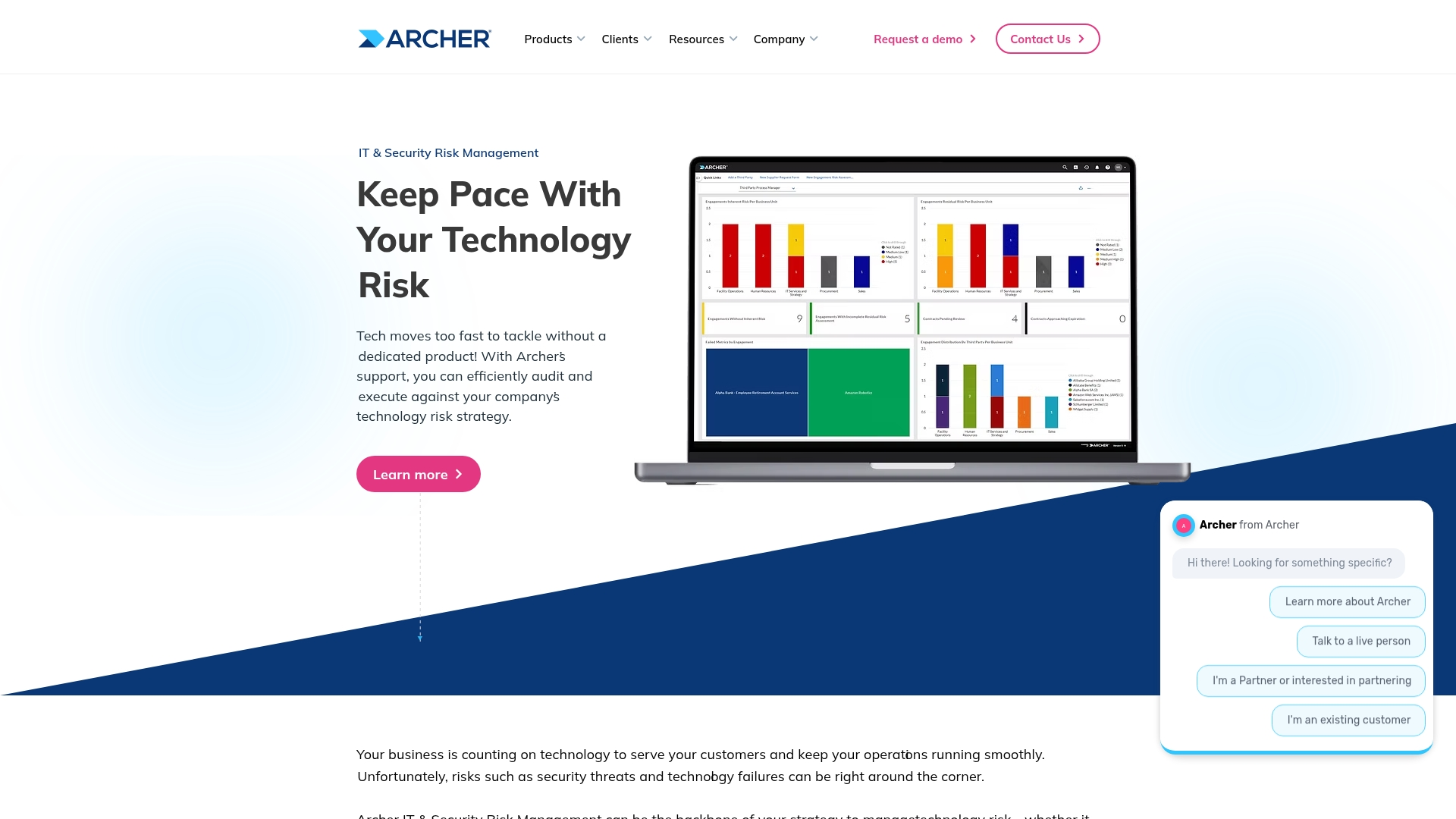
Key features:
- Integrated risk management platform: breaks down silos between different GRC functions to provide a holistic view of organizational risk across IT, security, and compliance domains.
- AI-powered Archer Evolv™ platform: leverages artificial intelligence and advanced analytics to automate regulatory change management and provide predictive risk insights.
- Comprehensive use case library: includes IT risk management, security vulnerabilities program, cyber incident response, PCI compliance, and cyber risk quantification modules.
Pricing:
- Pricing information: not published.
- Custom quote: contact their sales team.
Considerations:
- Steep learning curve: users frequently report that the platform’s extensive features and complex navigation require significant training and technical expertise to master effectively.
- High total cost of ownership: iImplementation, customization, and ongoing maintenance costs can be substantial, particularly for organizations requiring external consultants for setup and upgrades.
How to select the right IT risk management platform
As we’ve alluded to a little bit above, the selection process for an IT risk management platform should focus on identifying a system that unifies teams and data. The primary objective is to gain a clear, real-time, and holistic view of the risk landscape, enabling a strategic shift from reactive incident response to proactive risk mitigation.
This capability transforms a complex operational necessity into a distinct competitive advantage.
Always prioritize a platform that connects all operational components — from teams to existing tools— within a single, centralized hub. The right solution should aggregate information automatically, eliminating data silos and providing the complete picture needed for rapid, intelligent decision-making.
Ultimately, the best platform is one that your team will readily adopt. An intuitive, flexible solution that can be moulded to fit your unique processes is far more valuable than a rigid system that forces you to adapt. When a platform is easy to use and provides immediate clarity, it elevates risk management from a necessary chore to a strategic organizational win.
Best practices for risk management systems implementation
A successful implementation of a new risk management system hinges on a well-defined strategic plan, not a simple technical deployment. The process should be approached as a collaborative project, designed to build consensus and ensure all stakeholders are aligned. Breaking the rollout into clear, manageable phases transforms a potentially complex transition into a series of achievable milestones for the entire organization.
Key best practices for a smooth implementation include:
- Establish shared goals: begin by establishing shared goals to turn key stakeholders into advocates from the outset, ensuring buy-in across the organization.
- Careful data migration: conduct a careful data migration process, ensuring the new system feels like a natural extension of the team’s existing workflow. This foundational work is critical for user adoption.
- Phased rollout: transform the complex transition into a series of achievable milestones by breaking the rollout into clear, manageable phases.
- Leverage intuitive platforms: utilize platforms like monday service that offer an intuitive, no-code interface, empowering teams to customize workflows and integrate systems easily, turning best practices into new standard operating procedures.
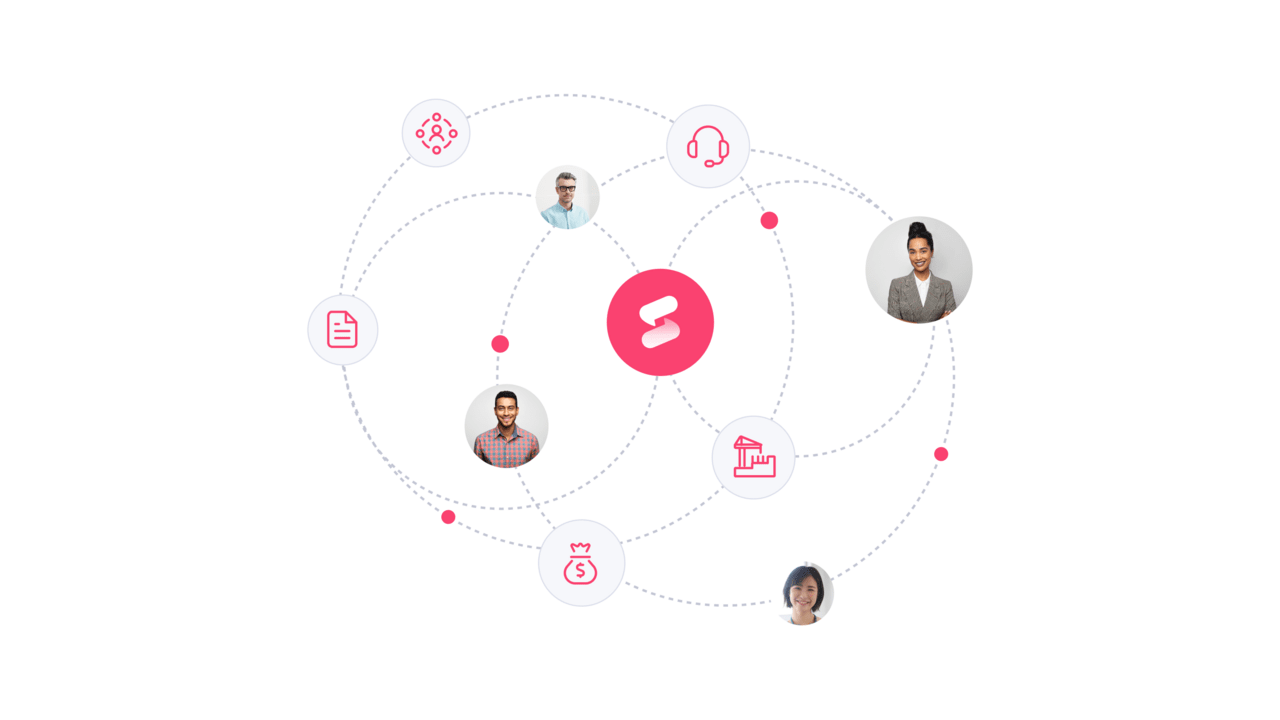
How to measure ROI from your risk management platform
Demonstrating the return on investment (ROI) for a risk management platform is also crucial for justifying its role as a strategic asset rather than just an operational expense. The key is to draw a direct line between the platform’s capabilities (such as streamlined workflows and automated compliance) and tangible financial outcomes. This provides leadership with the clear, quantitative data needed for informed decision-making.
It’s also about exchanging manual, chaotic processes for automated clarity. With a platform like monday service, teams can shift from constant firefighting to future-proofing operations. This transition allows you to finally quantify the value of reduced incidents, faster compliance cycles, and improved resource allocation.
Transform IT risk management with monday service
Effective IT risk management should not be a peripheral task that diverts focus from core business functions. By integrating risk management directly into daily service operations, it can be transformed from a burdensome requirement into a strategic advantage that enhances organizational foresight and resilience.
With monday service, risk workflows are unified with tickets, projects, and team collaboration in a single environment. Its built-in AI functions as an intelligent monitoring system, flagging potential issues from service patterns, while the intuitive no-code builder allows you to create custom risk assessments that teams can easily adopt.
Ready to shift from a reactive stance to a leadership position? Equip your team with integrated tools to transform risk oversight from a frantic scramble into a powerful strategy today.
The content in this article is provided for informational purposes only and, to the best of monday.com’s knowledge, the information provided in this article is accurate and up-to-date at the time of publication. That said, monday.com encourages readers to verify all information directly.
Frequently asked questions
How long does IT risk management software implementation typically take?
Implementation timelines vary significantly. While complex, traditional enterprise systems can take several months to deploy, modern SaaS platforms with intuitive designs and pre-built templates can often be operational in a much shorter timeframe.
What is the average cost of enterprise risk management platforms?
Costs for enterprise risk management platforms range widely based on the organization's size, the number of users, and the specific modules required. The best value is typically found in platforms that offer scalable pricing and deliver clear, immediate benefits without bundling unnecessary features.
Can IT risk management platforms integrate with existing service desk software?
Yes, a key feature of modern IT risk management platforms is their ability to integrate with other systems, including service desks. This connectivity allows teams to manage risks and related service tickets within a unified environment, improving efficiency and context.
How does AI enhance IT risk management capabilities?
AI enhances risk management by automating threat detection, performing predictive analysis on risk data, and prioritizing alerts. These capabilities provide teams with actionable insights, enabling them to address potential issues proactively before they escalate.
What compliance frameworks should IT risk assessment software support?
Effective risk assessment software should support major compliance frameworks relevant to your industry, such as ISO 27001, NIST, and GDPR. Look for platforms that use templates and automation to streamline compliance activities, integrating them into standard workflows.
What is the difference between IT risk management and GRC platforms?
IT risk management specifically addresses technology-related risks, such as system failures and cybersecurity threats. GRC (Governance, Risk, and Compliance) platforms have a broader scope, providing a framework to manage risk across the entire organization, including financial, operational, and legal domains.
 Get started
Get started 

